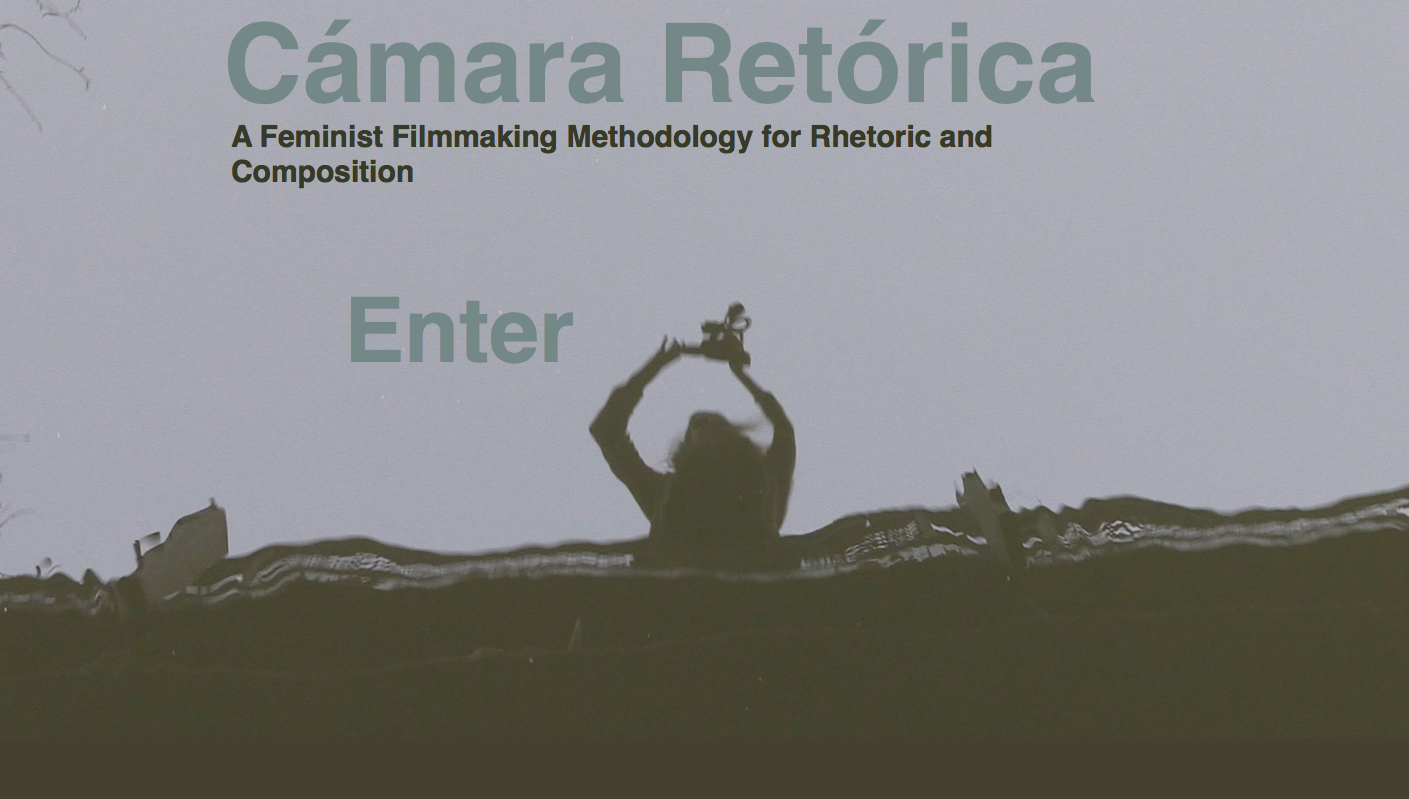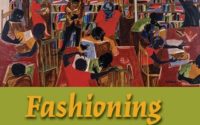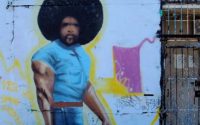Book Review: Hidalgo’s Cámara Retórica
Hidalgo, Alexandra. Cámara Retórica: A Feminist Filmmaking Methodology for Rhetoric and Composition. Logan, UT: Computers and Composition Digital P/Utah State UP, 2017. Free/Open-Access. ccdigitalpress.org/camara/
 Critical and creative image/video projects play a necessary role in an era in which the politics of (in)visibilty demand our attention. Alexandra Hidalgo’s Cámara Retórica: A Feminist Filmmaking Methodology for Rhetoric and Composition, investigates feminist filmmaking as a social and global imperative as it visually and verbally articulates a feminist filmmaking methodology that is at the same time flexible, practical, and critical. Hidalgo’s unique video book addresses feminist filmmaking professionals and students of rhetoric and composition as she argues that moving images made by rhetoricians are teachable, publishable, and tenure-worthy projects. However the video-book’s style make it an appropriate choice for a variety of disciplines, classrooms, and students at varying stages of the video making process.
Critical and creative image/video projects play a necessary role in an era in which the politics of (in)visibilty demand our attention. Alexandra Hidalgo’s Cámara Retórica: A Feminist Filmmaking Methodology for Rhetoric and Composition, investigates feminist filmmaking as a social and global imperative as it visually and verbally articulates a feminist filmmaking methodology that is at the same time flexible, practical, and critical. Hidalgo’s unique video book addresses feminist filmmaking professionals and students of rhetoric and composition as she argues that moving images made by rhetoricians are teachable, publishable, and tenure-worthy projects. However the video-book’s style make it an appropriate choice for a variety of disciplines, classrooms, and students at varying stages of the video making process.
In this six chapter video book, Hidalgo culminates her experiences in creating five documentary films and more than five years’ experience as a feminist filmmaker, a scholar, a mother, and Venezuelan immigrant in order to articulate the multiple moving pieces that go into making moving images. By making visible, or transparent, her own filmmaking choices in her video book, Cámara Retórica, Hidalgo details a feminist praxis in filmmaking, one that requires a critical inspection of videographers’ choices throughout the filmmaking process by “fostering diversity in front of and behind the camera.” Cámara Retórica is a video book about the value of feminist filmmaking praxis and is also a tool or guide for students, professors, and departments who engage with moving images in their scholarship and teaching.
Cámara Retórica is an interdisciplinary, broad-reaching video book, which makes it an exceptional choice for students and educators thinking about the importance of visuals, filmmaking, and rhetoric in their classrooms within fields such as gender and women studies, film, art, communication, mass media, and digital humanities. The video book is accessible on an open-media/open-access platform, making it free and available to a broad viewing audience. Furthermore, because the chapters are each separate videos, one can choose their style of viewing—for example one can watch chapters 1-6 in sequence, or screen the videobook for a class and only play specific chapters. I found reading the introduction and watching the first three chapters of the book to be most helpful for my ENGL 109H (“Advanced First-Year Composition”) class, as these helped us begin to understand the terms: rhetoric, visual rhetorics, feminist filmmaking, primary source materials, and archives. Hidalgo’s book served as both a model and an instruction in student’s visual rhetoric projects. Hidalgo’s video book extends beyond traditional logocentric scholarship and serves the growing population of English speakers who thrive when using visuals to inform their educative practices, that is audiences who benefit from visual and auditory learning. Furthermore, full alphabetic transcripts are available, and the video book is also dowloadable and available on YouTube and Vimeo through the book’s website.
In the video book the “viewer” experiences knowledge through words, images, movement, and sound. Perhaps even taste or smell, as one does not have to sit still in one place in order to understand and make meaning of the video book and can imagine along with what they are watching. In the first set of chapters, Hidalgo lays a foundation of history, terminology, and taxonomies of film and video production within and outside of rhetoric and composition. I found the first three chapters helpful to begin to understand the uses of filmmaking within many academic fields while centering rhetorical and compositional gestures. Here, Hidalgo describes how feminist filmmaking pieces are activist in nature and seek “to foster social justice and equality” (Chapter 1). As a video maker and instructor of rhetoric and composition, I found Hidalgo’s second chapter clear and vital to feminist filmmaking. Here Hidalgo introduces her five “Principles of Feminist Filmmaking” which include:
- Foster Diversity in Front of and Behind the Camera
- Engage in an Ethics of Interdependence with Crewmembers
- Engage in an Ethics of Interdependence with Documentary Participants
- Practice Mentorship
- Practice Strategic Contemplation
These are important to note here because as key principles they are important to the overall purpose of the video book. As well, they are keys to Hidalgo’s methodology and are terms she uses throughout the video book. Here Hidalgo bridges the philosophies and practices of rhetoric and composition with those of feminist filmmaking.
The second set of chapters (4 and 5) detail more specifically the possibilities and limitations of video production in academia and how best to present material for publishing purposes, funding, grants, submitting to film festivals, and making video scholarship count toward scholarship and tenure. These chapters require careful consideration for those who take up film and video production in meaningful ways and seek to legitimize their work within the field and within academia. Hidalgo also presents audiences with peer-reviewed journals and article examples that discuss the ways in which film and video production can count toward merit, tenure, and promotion. Hidalgo’s Chapter 6 of Cámara Retórica serves as a wake-up call to the field of rhetoric and composition to recognize and value more seriously moving images and the process of video making. Internet and online video watching are growing exponentially, and it is key for the field to consider the place of video making as a powerful tool to construct meaning and arguments. While rhetoricians are not always formally trained in video recording and video production, a rhetorician’s training teaches one to think strategically about all the “moving” pieces of an argument, including lighting, framing, and editing but also our choices of words that get recorded, “voice” or voices that are included, and how they are represented.
In this unique approach to rhetoric and composition scholarship, the viewer hears Hidalgo’s pleasant voice narrating along with a musical score, adding to the sensorial aspects of research and scholarship. Seeing Hidalgo, her children, and her crew listening to her critiques and self reflections, as well as those of other filmmakers, makes this work a humanizing project and a valuable feminist multimedia tool. To watch/see her personal family videos as well as the finished projects of other rhetoric and composition scholars permits the viewer insight into projects we may only have read about, thus connecting us with our favorite scholars through a new lens. The transparency into her project, and into feminist methods and research, permit the reader/audience an intimate perspective into the labor of film and video production. With a growing demand for visual articulations, Cámara Retórica is both nuanced and timely.
Keywords: videobook, feminist filmmaking, digital humanities, multimedia, digital archives




 Alejandra is currently a doctoral candidate at the University of Arizona, Tucson. She is a single-parent to two young children, Dominick & Xavi. She spends most of her time thinking, writing, photographing the world around her, and painting abstract images of her dreamscapes. You can find her singing rancheras at a local restaurant, jumping out of airplanes, into rivers, lakes and oceans, or staring intently into the cosmos.
Alejandra is currently a doctoral candidate at the University of Arizona, Tucson. She is a single-parent to two young children, Dominick & Xavi. She spends most of her time thinking, writing, photographing the world around her, and painting abstract images of her dreamscapes. You can find her singing rancheras at a local restaurant, jumping out of airplanes, into rivers, lakes and oceans, or staring intently into the cosmos.